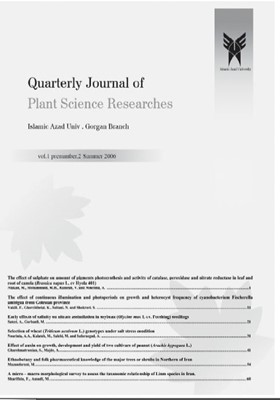-
-
List of Articles
-
Open Access Article
1 - The effect of sulphate on amount of pigments photosynthesis and activity of catalase,peroxidase and nitrate reductase in leaf and root of canola (Brassica napus L. cv Hyola 401)
Maryam Niakan Mohammad hossain Mohammadi Vali ollah Rameah Abbas ali Nourinia -
Open Access Article
2 - The effect of continuous illumination and photoperiods on growth and heterocyst frequency of cyanobacterium Fischerella ambigua from Golestan province
Fereshte Vakili Kayvan Ghorchibeigi Neda Soltani Shadman Shokravi -
Open Access Article
3 - Early effects of salinity on nitrate assimilation in soybean (Glycine max L cv. Pershing) seedlings
Arian Sateie Mahlagha Gorbanli -
Open Access Article
4 - Selection of wheat (Triticum aestivum L.) genotypes under salt stress condition
Abbasali Nourinia -
Open Access Article
5 - Effect of auxin on growth, development and yield of two cultivars of peanut (Arachis hypogaea L.)
-
Open Access Article
6 - Ethnobotany and folk pharmaceutical knowledge of the major trees or shrubs in North of Iran
معصومه Mazandarani -
Open Access Article
7 - A micro – macro morphological survey to assess the taxonomic relationship of Linm species in Iran
فریبا Sharifnia مصطفی Assadi,
-
The rights to this website are owned by the Raimag Press Management System.
Copyright © 2021-2025







